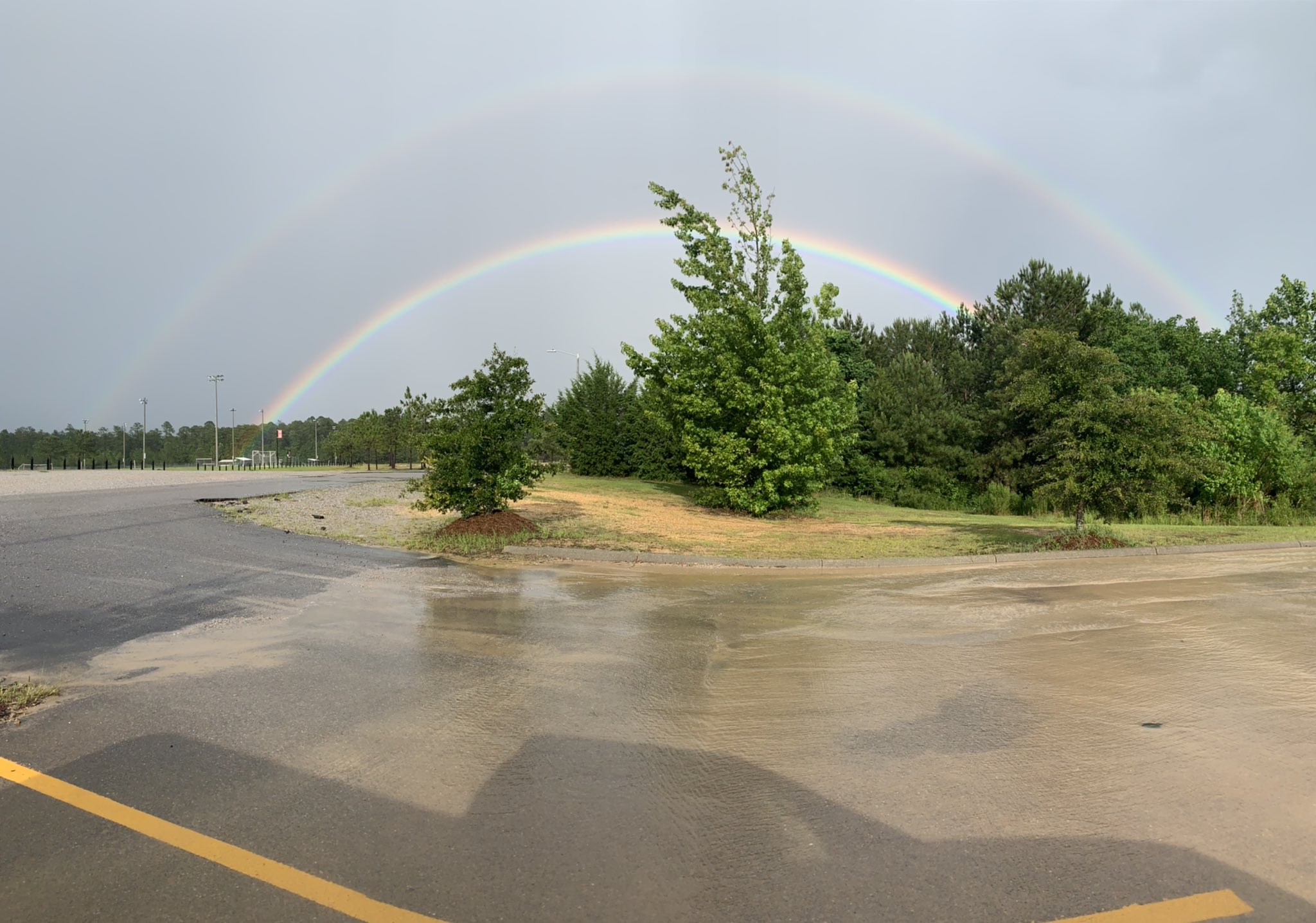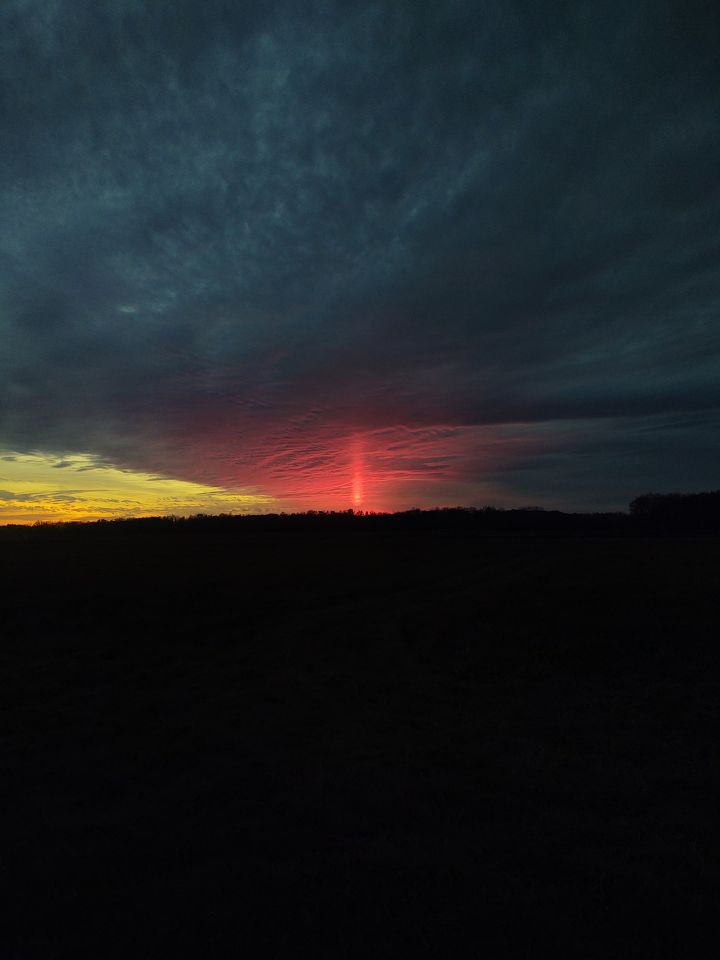I didn’t plan on writing this piece today, but back-to-back really cool things happened in the atmosphere recently. Light pillars in Alaska and Halos in Mississippi.
So what causes all of these optical illusions? Our atmosphere and the stuff in it! It messes with the light from the Sun and makes all types of cool effects.
It turns out that light is really cool because as it is bent, reflected, refracted, and slowed down, it changes what it looks like. Because it is both a particle and a wave, you can thing of the wave acting a bit like a wave of sound, in a sense. As sound is reflected, reacted, bent and slowed down, it ultimately sounds different.
With light, when you do the same things, it looks different. And a great example of this is when light passes through a prism.
As it does, the light is broken apart into its ‘seven’ colors as parts of the light beam slow down more than others.
But before we dive into everything, let’s got back to school really quickly…
Electromagnetism
Remember the Electromagnetic Spectrum? It is the chart showing the spread of light from high energy to low energy. And recall that as light waves slow down, they go from higher energy to lower energy. And that fact is is how we get rainbows! Because for visible light, the light beam slows down from violet light to red light.

But as you can see, we could slow down any light from any speed to another speed. For example, light could slow from infrared to microwave. Or from X ray to ultraviolet. All you have to do is find a medium to pass that light through that can slow it down.
TANGENT ALERT!
You’ve probably heard about radiation from X-ray machines or radiation from UV-radiation from the Sun. Well, it turns out that all light – even visible light – is a form of radiation. But, there are two kinds of radiation. Let’s get word on that straight from the EPA:
Non-ionizing radiation has enough energy to move atoms in a molecule around or cause them to vibrate, but not enough to remove electrons from atoms. Examples of this kind of radiation are radio waves, visible light and microwaves.
Ionizing radiation has so much energy it can knock electrons out of atoms, a process known as ionization. Ionizing radiation can affect the atoms in living things, so it poses a health risk by damaging tissue and DNA in genes. Ionizing radiation comes from x-ray machines, cosmic particles from outer space and radioactive elements. Radioactive elements emit ionizing radiation as their atoms undergo radioactive decay.
I only bring up radiation to make a different point about something unrelated. Some folks worry about 5G cell phone signals messin’ with stuff. But 5G (like 4G, 3G, 2G, and all the other cell phone signals) is still a microwave light beam. There isn’t enough energy on the beam of light to do much more than jiggle an atom.
In fact! The 5G your phone uses has a frequency between 25-45GHz. That is less energy than the Cosmic Microwave Background. The CMB are light waves that permeate the entire cosmos. And those light beams are moving through you right now! And the CMB sits around 160 GHz. That is nearly three-times the energy!
In fact again! The visible light being produced by the screen you are looking at has way more energy. Blue light sits at 7.5 × 1014 Hz Or 750,000 GHz.
And if someone wanted to ‘mess’ with stuff, it would be much better to use light with a higher energy. So using microwaves is not a good means of doing so.
Plus! Microwaves and water have a very special relationship. It turns out that water absorbs microwaves really easily. In other words, the water molecule like to jiggle when it with microwaves.
This leads to two things that are a big part of every day life: poor reception on your cell phone during a thunderstorm and heating up food quickly in the microwave oven!
It also means if someone was trying to “control your brain with the 5G,” it wouldn’t work very well in places whenever it rained. Rendering such a plan almost useless across much of the world.
… OKAY WHERE WAS I?
Oh Right! So as light passes through a medium it will slow down. And out atmosphere is a great medium!
Rainbows
Who doesn’t love a good rainbow?

Rainbows occur when light is bent and reflected back toward you from a distant rianshower.

So as the sunlight enters the falling raindrop it is bent, then it reflects back, and is bent a second time. All the while it is also slowed down because the wave has to physically move through the water droplet. This changes how you, the viewer of that light beam see it.
The folks over at Georgia State have an excellent diagram that I can’t improve upon.

One thing the folks at Georgia State point out is that the rainbow forms a full circle around the “anti-solar point” which is actually the shadow of your head on the ground. this means that you can also use that point to find the rainbow of a waterfall or sprinkler hose, or mist. Neat stuff!
Sometimes there is a secondary rainbow, too. Double rainbows aren’t as common, but can happen in the right conditions.

This happens when the light is reflected off the water droplets twice. The second rainbow will always feature three things: It will be about 10-degrees larger, feature a reverse order of the colors and be about 10% as bright.
Halos
The most common type of halo is the 22-degree halo. This is a ring around the sun or moon that is 22-degrees from the point of origin. Often these halos form from suspended ice crystals. But you know what, I’m going to let Jacob, the South Mississippi Weather Geek, explain…
Jacob is spot on! The hexagonal crystals are column-type ice crystals, with a diameter of less than 20 micrometers. The refraction of light through these crystals forms a halo. Less common is the 46-degree halo, which forms in a similar way but with more column-type ice crystals that have diameter slightly large, up to 25 micrometers.

In the above picture a Tangent Arc is barely visible on the right side of the halo. This happens when falling hexagonal ice crystals are oriented horizontally.
Sun Dogs
Sun dogs develop in a similar way to a tangent arc. Hexagonal ice crystals refracting light.

The brightest part of the reflection is along a horizontal plane away from the sun. The University of Illinois has a great diagram depicting how sun dogs form.

The main difference between a halo and a sundog is the bright spot is from the ice crystals all being aligned horizontally.
Sun pillars & Light pillars
Now, I could’ve sworn that I had a picture of a sun pillar. I remember taking pictures of one in January of 2017 or 2018 on I-10 driving west into Mobile, AL. But, for whatever reason, I couldn’t find it.
And honestly, it wasn’t as good as this one I found from Jay Wappula posted on Twitter by Hutch Johnson.

Sun pillars are another example of ice crystals reflecting sunshine. In this case, it happens when the sun is setting (or rising) and it is doing so while the viewer is underneath some high clouds with ice crystals falling toward the surface (slowly). The sunlight reflects off the bottom of the ice crystals as they fall (like a leaf, falling from a tree in the Autumn).
Light pillars are a similar situation, but without the sun. The image below, pulled from twitter, was posted, asking a great climatologist and meteorologist, Brian Brettschneider, how they work.

These kind of light pillars require some very, very cold air to be in place. It also needs to be saturated enough so that any ice crystals in the air don’t sublimate. In this case, lights from the city are being reflected from these suspended ice crystals.
But why in just a straight line up?
It is because the viewer has to be at a certain angle relative to the ice crystals orientation. If you were to walk down the road from where this picture was taken, different light pillars would develop and others would disappear.
The Bottom Line
Light is cool! Our atmosphere is cool! Put them together and cool things happen!
A lot of times people want to credit aliens or some supernatural event for naturally occurring optical illusions that develop in the atmosphere given all the stuff (usually ice crystals) that is floating around.

